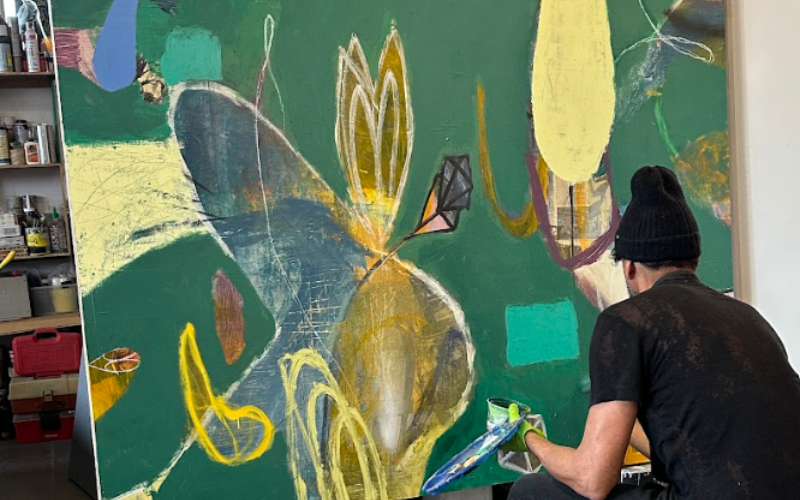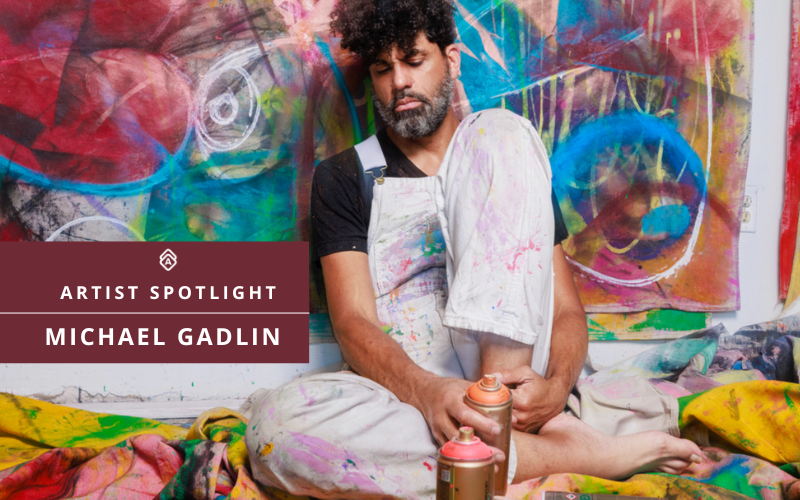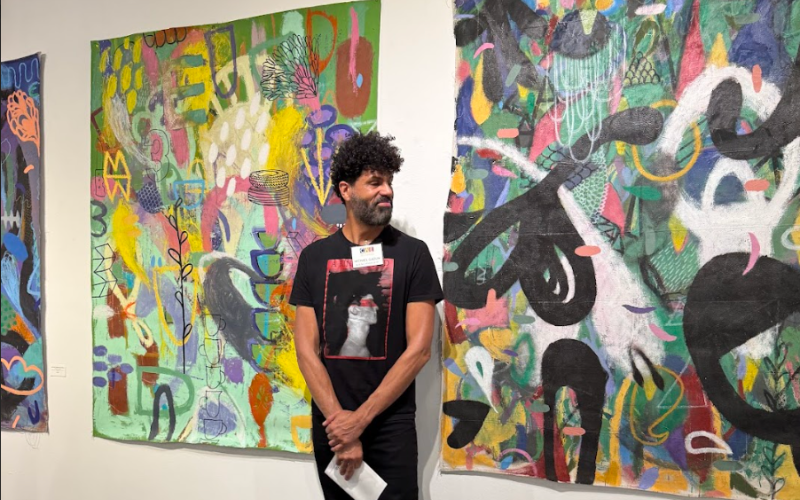Artist Michael Gadlin, Photo credit Holden Kudla
"Color was once not found (or found very little) in my early work. So I've now overcompensated by using every bit of color I can find."
Featured Artist Michael Gadlin is a Denver-based painter known for his layered, abstract compositions—and for bringing contemporary art into people’s living rooms as a host of Rocky Mountain PBS’s Arts District.
While he spent formative years in New York studying at the renowned Pratt Institute of Art and Design, Gadlin ultimately returned to Colorado, where his creative practice continues to evolve in dialogue with the city’s shifting urban landscape. He is represented by K Contemporary, a gallery in Denver known for championing innovative and influential contemporary artists.
“My process relies on an evolving dialogue guided by historical techniques,” Gadlin shares. “Each mark, layer, and revision reflects an ongoing conversation between material and meaning, leaving behind traces of the moment I find myself observing.” His work explores the tension between abstraction and symbolism, where dense compositions emerge through spontaneous mark-making and deliberate layering.
Influenced by graffiti, classical art, and the energy of city life, Gadlin describes his paintings as “dense amalgamations of symbols and abstraction drawn from the chaotic urban landscape.” At the core of his practice is a desire to explore memory, imagination, and shared human experience. “Beauty lies in the tension,” he says, “where layers create relationships that shape the viewer’s experience.”
With every painting, Gadlin invites the viewer into a visual conversation—one that challenges assumptions, honors intuition, and leaves space for meaning to surface through the materials themselves.
Artwork Archive had the chance to chat with Michael Gadlin about his creative process, how he found his way to exploring color, and why Artwork Archive is important to his art career.
You can see more of his work on Discovery and learn more about his art practice below:
Michael Gadlin standing in front of his work. Photo courtesy of the artist
Making the First Mark:
Michael Gadlin starts with a blank canvas—literally. No stretchers, no sketches, no mapped-out plan. He goes straight into drawing on raw fabric, and lets the first mark set the tone.
It’s a method rooted in trust. “I’ve always been interested in what an initial mark says to you and how you respond to each mark consecutively,” he muses. The very act of responding is what leads this artist forward. “It’s part of what I call the intuitive approach. Responding to the material in a very open way."
Each mark holds weight and carries a kind of question. He listens to what it’s asking and answers with the next one—never quite sure where it’ll lead, but always paying attention.
Letting Color Take Over
Look at Gadlin’s recent work and one thing becomes clear: color floods the canvas. But that wasn’t always the case. “Color was once not found (or very little) in my early work,” he recalls. “So I’ve now overcompensated by using every bit of color I can find.”
His studio is full of objects and materials that catch his eye, even if he’s not sure when—or if—they’ll show up in the work. He half-jokes that he’s “a minimalist (by aesthetic) trapped in a maximalist brain,” but it tracks.
Color doesn’t quietly settle into the background. It comes crashing in. “It feels like being attacked by many colors aggressively altering the space in front of me.” That intensity keeps him engaged. It’s where the momentum lives.
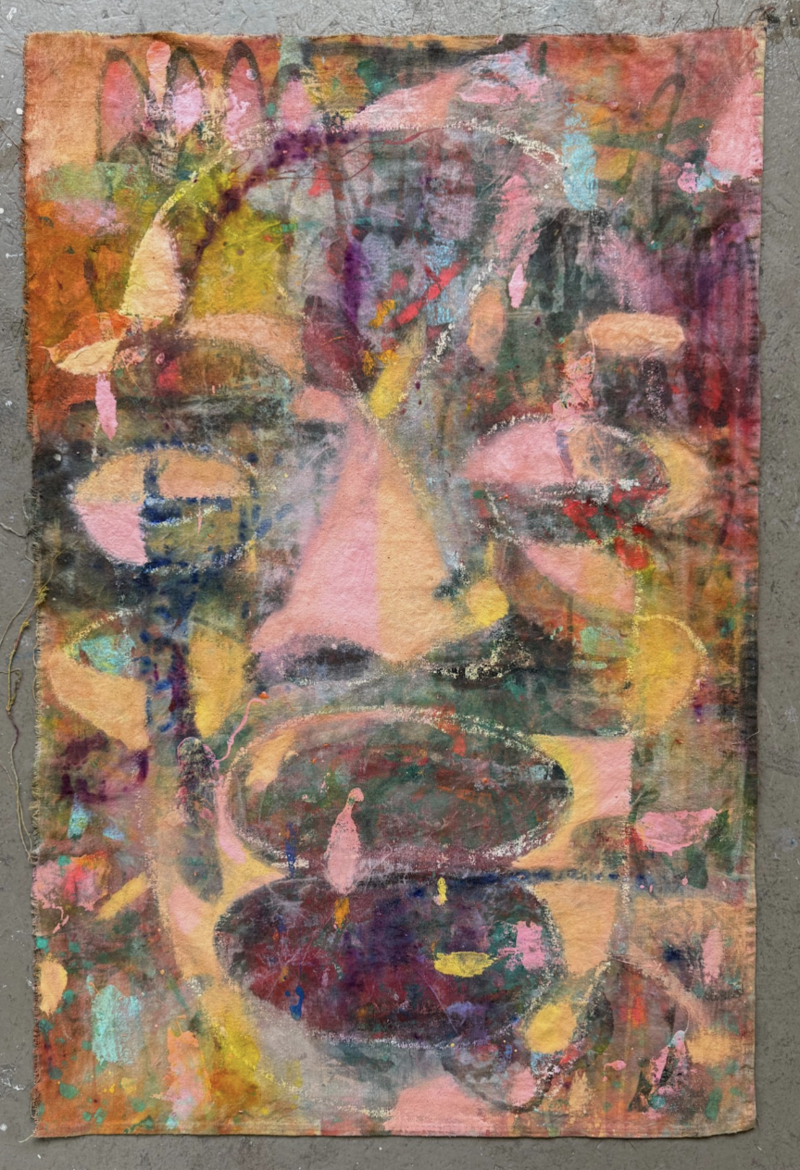
Michael Gadlin, Portrait of An Ancestor, 2025, 53 x 34 in
Unscripted and Intuitive
There are echoes of art history in Gadlin’s work, but they’re not intentional. When critics pick up on art historical references in this particular body of work, they're usually seeing something that happened on its own. “My process is not led by anything referenced consciously,” he notes. “We are all influenced by something that we’ve had an emotional resonance to,” but for him, that influence moves quietly beneath the surface.
The artist doesn't build a piece around a known concept or tradition. Instead, he moves from mark to mark, open to surprise, letting the materials and the moment take the lead. He then relies on his eye to edit, to eliminate, and to shape what emerges through the process.
The final work, he believes, is “an authentically individual statement of the moment I put myself into.”
Getting Unstuck Starts with Stepping Away
Like most artists, there are times when the studio feels distant for Gadlin, even if he hasn’t physically left it. When that happens, he gives himself space. His studio opens to a trail, and he often takes a walk just to clear his head. Other times, it’s a slower kind of reset. He’ll make tea, pull out an art book, and just...sit with it.
“I have a huge library of art books, and it gets me back to remembering that nothing is too serious; it’s what we make of what’s in front of us that matters.”
Other times, when that pause isn't enough, he reaches for something low-stakes: unfamiliar materials, leftover scraps, anything that doesn't feel precious. “The key is to not have an end goal,” he shares. “Just let go of assumptions and make stuff that you are uncomfortable with. That leads to necessary discovery.”
He’s seen how easy it is to stay in routines that feel productive but eventually flatten out. His way back is always through experimentation, reconnecting with the sense of freedom that first pulled him into artmaking.
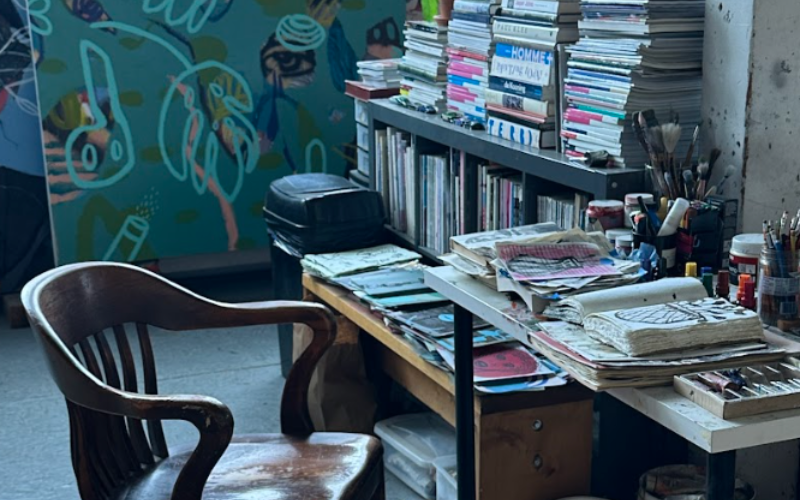
A peek into Michael Gadlin's studio. Photo courtesy of the artist
The Mindset Shift That Matters Most
Michael Gadlin doesn’t believe in waiting for someone to hand you your moment. “Become the artist you know you are,” he advises. There’s no magic timeline, no secret code. You show up. You get clear. You build the thing.
His perspective comes from years of doing the work. And he knows that building a career in the arts takes more than momentum. “There are no shortcuts,” he warns. “The best thing an artist can do is get really organized and disciplined about how they spend time in the studio.” The artists who keep moving forward are the ones who treat their time like it matters. They don’t wait to be chosen. They start laying the foundation now.
Do that long enough, and you'll create a ripple effect. “Watch how people start investing in you because of the trust and clarity you bring to the table.” People notice when an artist is clear on what they’re doing and why. That energy is contagious, but it has to start with you.
Gadlin also makes it a point to block out anyone who tries to dismiss your creative path. “Don’t waste time with people who doubt this career or have nothing supportive to contribute,” he cautions. Too often, those doubts come from a limited view. "Most of the skepticism, he adds, comes from people who simply don’t understand the art world. “They assume it’s not feasible because they don’t have the imagination to see how it could work.”
Learning to Think Like a Business
One of the hardest lessons for many artists is learning that being a professional artist means being an entrepreneur. Gadlin puts it plainly: “You’re 100% commission in this gig. Go out and show people what you’re good at—because that in and of itself is a skill set!”
He didn’t always frame it that way, and understanding that he was building a business came gradually. “To absolutely believe that what I was actually doing was becoming an entrepreneur and act accordingly,” he explains, was something that took time and experience.
With that shift came a new kind of responsibility:
Gadlin started paying attention to how his work was documented and managed. He didn’t want to lose energy to back-end clutter, so he found a tool that helped him streamline and protect his process, starting with how he handled inventory.
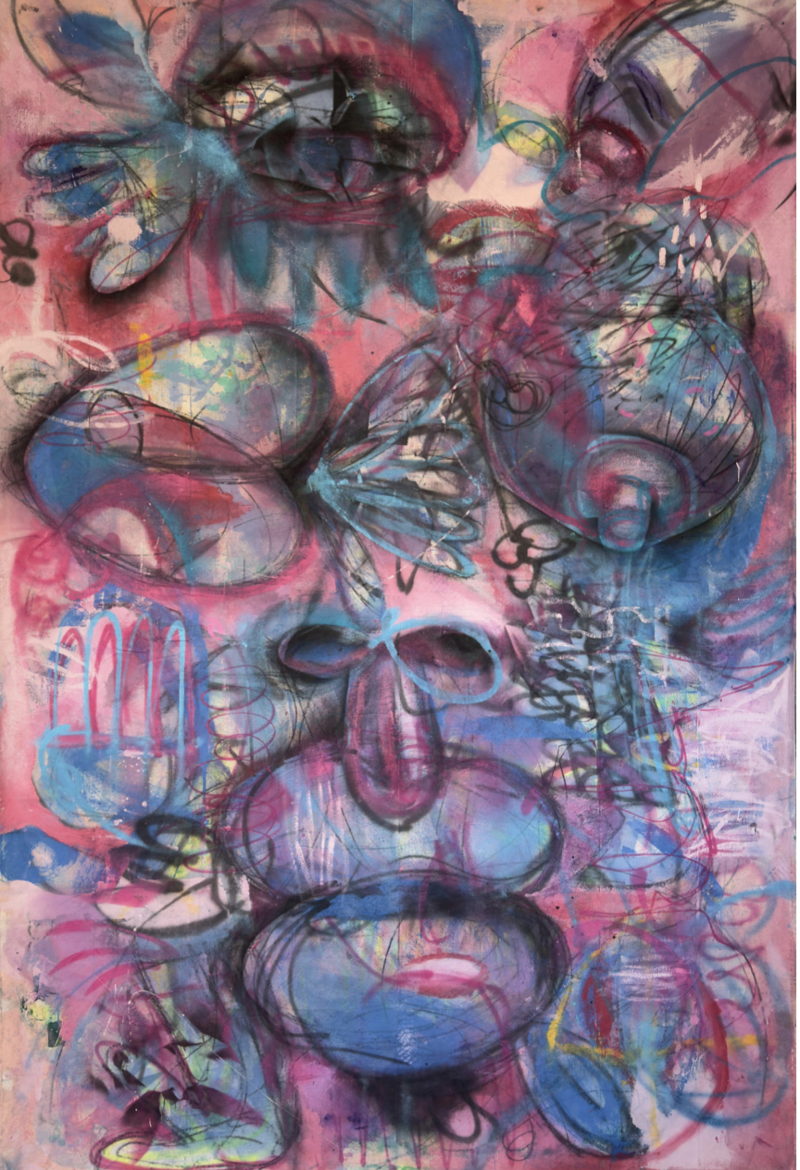
Michael Gadlin, Flavor is The Most, 2025, 104 x 72 in.
Why Gadlin Chose Artwork Archive
Before Artwork Archive entered the picture, Gadlin was already experimenting for better ways to manage his inventory. While running ArtHaus, a Denver gallery he co-founded and managed alongside launching his own career, the admin side started piling up.
“I realized I was not good at creating the necessary spreadsheets,” he remembers. “Something I've since come to appreciate.”
With his work packed in storage and no smooth system in place, rigged his own solution. He taped QR codes to the packaging—each one linked to images and artwork details, so viewers could access information without unwrapping the piece. That fix worked for a while, but eventually he needed something better.
When he discovered Artwork Archive, it felt like a studio-level exhale. “It was the best thing for me getting my head out of the weeds.” No more scattered systems. No more relying on workarounds. And, lo and behold, a new way to experiment with QR codes—this time within a platform where everything already had its place.
“I despise the little but necessary tasks that take me away from being creative," Gadlin admits. Artwork Archive lets him hand those off, and return to what really drives him.
Studio Storage Made Smarter:
Michael’s original QR code solution helped him keep track of wrapped works in storage.
With Artwork Archive, he can still label and scan his way through inventory—but now his QR codes connect to a full database. Pricing, details, provenance—it’s all there, ready to pull up in seconds, whether he’s in the studio or offsite.
Keeping the Work in Focus
Michael Gadlin is an artist who likes being able to step back and see his work as a whole. Artwork Archive gives him a way to do that.
One thing he returns to often is Artwork Archive’s portfolio and collection tools. He creates selections tailored to each situation—whether it’s preparing for a show, putting together a residency application, or just checking in with how a series is evolving. "It helps me to see my work in context," he notes.
The platform has also become part of how he handles submissions and requests. He applies to calls directly through his account and is able to create Certificates of Authenticity when collectors ask for them. "It's so cool that I can just go in and create the necessary PDF to send them," he says.
“I look way more professional than I feel like I am. It’s flipping amazing.”
With the administrative tasks taken care of, he heads back to the part of the process he cares about most. “I just get back to painting because that’s what I really want to do and it’s what I’m good at… hehe!”
Reuse What You've Already Built:
When you apply for shows, grants, or residencies, there’s no need to start from scratch.
Your Artwork Archive account holds the images, details, and descriptions you need—plus a place to store updated versions of your bio, statement, and CV. Pull everything into a Portfolio Page or submission in minutes, then get back to making instead of digging through old files.
Sharpen Your Work and Strengthen Your Circle
Gadlin has mentored artists across many stages of their art careers. And, when talking to early-career artists—especially those assisting in his own studio—he finds himself often bringing up the same principle:
“Be careful of spending equal time on everything; you'll risk being a ‘jack of all trades, master of none,” he often reminds them. His advice is to stay focused and get really good at what comes most naturally. “You’ve got to perfect what you do.”
Equally important is knowing what your work is rooted in. “You’ve gotta know who you are as an artist and what your vision is." That’s the part that makes your work recognizable, and it’s what helps you stick with it through the harder seasons.
Then comes the piece that many overlook: the people who walk with you. "There is absolutely no person on earth living their dream who hasn’t had people play a significant role in supporting them.” He speaks from experience. “It's impossible to be the artist you want to be and think you’re gonna do everything alone in a vacuum.”
To Michael Gadlin, a thriving art career grows from what you sharpen on your own—and what you allow others to help you carry.
